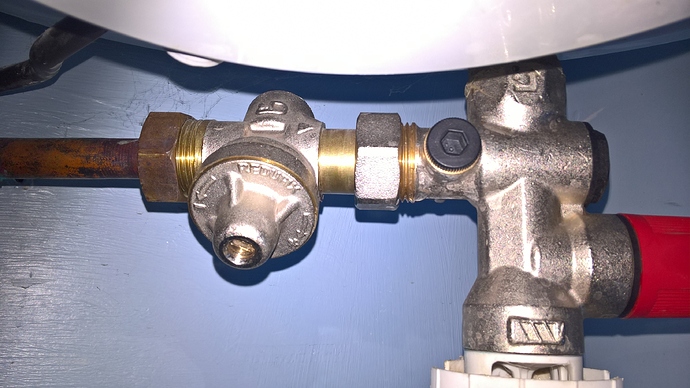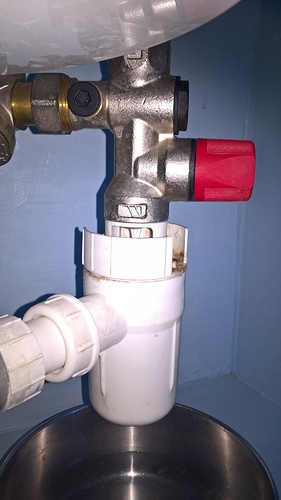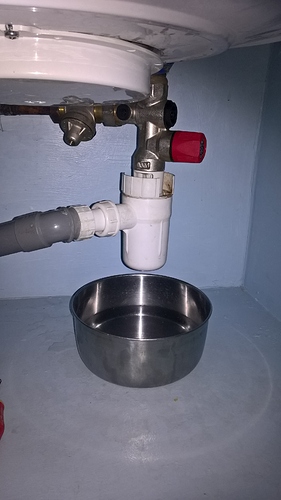Regarding your ‘Redufix’ valve, it does indeed seem to be a pressure reducer. Check that it is working correctly by turning it fully towards the ‘minus’ position. You should then find a considerable reduction in pressure of water coming from the hot tap. Then turn it slowly and incrementally in the plus direction until the pressure coming from the hot tap is just sufficient for your needs — the shower for example. I would do this as the first step in the fault finding process.
The Groupe de Securite should only discharge water when the heating element is working. Try turning off the electrical supply to the hot water tank, wait an hour (without using any hot water), and then see if it is still dripping. If it is, then the Groupe de Securite has a problem. Then try operating the drain valve briefly a couple of times to see if it resolves the problem. If not, then the Groupe de Securite probably needs replacing.
It would be helpful to know if the electrical supply to the hot water heater is on all the time, or if it is on a timer of some sort so that it only works at night for example ?
Also, is it fed with mains water, or water which is pumped from a private well ?
The temperature of the water delivered at the hot tap should not exceed 50 deg C.
I believe that if that temperature is exceeded, then the tap must be marked with a permanently affixed warning sign to indicate that the temperature is above 50 deg C. This is to avoid inadvertant scalding.
From your description it would seem that the water is currently way too hot for safety, so we need to check the thermostat function as follows:-
At a time when there is plenty of hot water in the tank, and the electrical supply to the heater is switched on, get another person to watch the electric meter whilst the tank heater thermostat is adjusted. You should probably be able to hear a slight click noise when the thermostat cuts in and out. The meter will give you an indication of when the heating element is drawing power, either by the speed of rotation of the dial (if it’s an old style meter) or the frequency of the flashing light on the newer types of meter. If the heating element continues to draw power when the thermostat is turned to the lowest setting (at a time when there is plenty of hot water in the tank), then the thermostat is faulty and needs to be replaced. In the interim you can roughly control the temperature by turning off the electrical supply to the tank.
For the longer term it is best to find the minimum temperature setting that suits your needs, not least from an economy point of view. Start with the thermostat on the mid setting (3 on your 1 - 5 scale) and then turn it down very slightly (a quarter of a number perhaps) each day until you find that you are running out of hot water, then turn it back up to the setting of the previous day and you should be fine. It will take a bit of trial and error over a few days, but the economy savings will be well worth the time and trouble taken to do this.
If you are using mains water, then there should be no need to have any particular thermostat setting to kill bacteria as there shouldn’t be any bacteria in the water in the first place. Just to be on the safe side, the usual advice is that water from the hot tap should not be used for drinking or cooking anyway.
If you are using well water, then you should have it analysed regularly to make sure it is safe to drink.
In your photos it looks like there is a bowl of water underneath the Groupe de Securite. If that is needed to catch overflow from the syphon during normal operation, then it would seem that the outfall waste pipe may be blocked somewhere, in which case it would be a good idea to unscrew the joints and check that the interior of the waste pipe is free and clear with a good flow to the drain.
It does seem very unusual that you have already had the Groupe de Securite changed twice in only three years of operation.Could well be that a combination of excessive pressure, and too high a temperature setting may be the cause of these rapid failures.
Whether or not limescale can be effectively cleaned from the hot water cylinder will depend on it’s make and design. Bearing in mind the cost of labour these days it may be cheaper to just replace the hot water cylinder with a new one.
Another thought that comes to mind is have you considered installing a relatively cheap electro-magnetic water softener ? No plumbing skills required — just a matter of tightly coiling the ‘aerial’ type wires around the main inlet cold water pipe. Switch it on and it silently and cheaply goes to work without any expensive chemicals being involved. It just makes the hard water temporarily behave like soft water by changing the ion polarity of the water molecules. I have used one for many years without any problems of furring up of appliance heating elements such as in washing machines, water heaters, or even my old fashioned kettle.
Good luck. Persevere and I’m sure that you will achieve economies in both water consumption and the cost of heating it.




